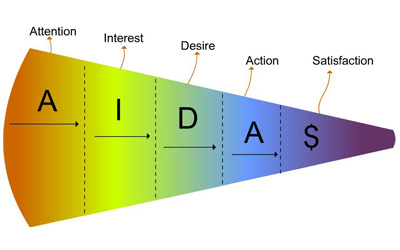Readers of this blog may be well acquainted with the AIDAS theory of selling. In essence, a prospect goes through five definitive stages before they are happy with a product. AIDAS stands for Attention – Interest – Desire – Action – Satisfaction. An SDR should start with grabbing the prospect’s attention towards themselves or the product before soliciting interest in the product. This is followed by creating a desire in the minds of the prospects which leads to the action; the process of actually buying the product. However, the sales process does not end here and moves on to offering great support, which is vital to customer satisfaction.
The AIDAS theory is not necessarily restricted to traditional sales models and is equally applicable to online sales as well. There is however an additional step in the process – Trust. In an online setup, customers are generally a little more wary about the authenticity of the seller and the legitimacy of the product. Assuring the customer and demonstrating your credibility is therefore necessary before soliciting an action.
Attention
In eCommerce, the attention towards your platform or the product sometimes begins even before your prospective customer has clicked on to your website. Pay per click ads, Facebook posts and even Tweets serve as a crisp and concise way to inform a prospect about the product you are offering and your unique selling points. A 20% discount offer, for instance, is attractive bait that can grab a visitor’s attention towards your product.
Interest
Once you have your prospect’s attention, the next step is to build interest. This is specifically served by your site’s landing pages. I have previously written about generating interest in my previous article here. To summarize, a landing page should talk about who you are and what you do. More importantly, it should talk about what you can do to solve the customer’s problem. Encapsulating this messaging without taking up too much real estate on the page is crucial to customer conversion.
Desire
Solely creating interest around your product is insufficient to drive prospective customers to convert. It is also important to generate a desire in them to get a hold of your product. In the brick and mortar world, this is achieved with the help of live demonstrations and also allowing your customers to “touch and feel” the product. Studies have shown that this creates a sense of ownership, which triggers potential customers to pay for your product.
At the outset, this can be tough to achieve online. However, one advantage that eCommerce has over physical retail is that unlike live demonstrations, that can sometimes fail to go as planned, online product demos can be produced to perfection. Hire a professional agency that can help you product visuals that create a desire among your visitors.
Trust
A desire to buy does not always translate into actual purchase. Fear of losing your personal data, including credit card information to an untrusted seller, is often the primary reason why visitors don’t convert. A cursory look at eCommerce marketplaces like Exchange shows that one common thread among all the successful online stores is how they gain the trust of the customer by showcasing security badges like those from Visa and Mastercard. In developing countries where credit card penetration is low, it is common for sellers to offer ‘cash on delivery’ – meaning that eCommerce stores are only paid upon delivery of goods, which is a very effective method to build trust. Advertising your free returns or replacement policy can also go a long way in eliciting trust in potential buyers.
Action
A successful eCommerce business packs all information pertaining to the product, the company and the trust symbols in one page. This can get overwhelming for the customer and can distract them away from the goal of making the purchase. A prominent ‘call to action’ prompts the visitor to go ahead with the purchase. CTAs are not just about placing an attractive button, but also making use of the right trigger words and appealing to the buyer to take instant action. This article on WordStream is a good guide on this topic.
Satisfaction
A successful business transaction does not end with customer conversion. To build a successful business, it is important to deliver on your promises. One of the best ways to ensure this is by offering multi-channel customer support platforms that let customers quickly and easily reach out to a human rep to get answers on any questions relating to shipment or technical issues.
ECommerce offers a way to shop conveniently and this is a reason why millions of customers have started choosing this medium over physical retail. But given the intense competition among sellers, it is important for your business to adhere to the AIDAS theory on your site lest you lose your customer to a competitor.












Comments